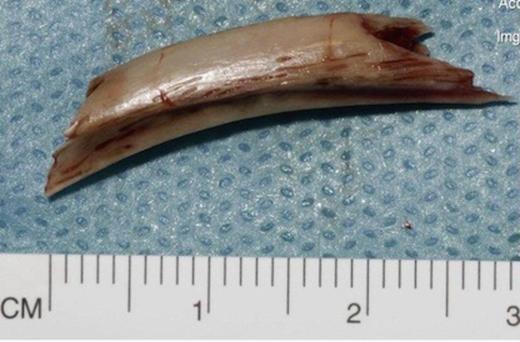-
PDF
- Split View
-
Views
-
Cite
Cite
L Kocierz, E Leung, V Thumbe, An unusual cause of perianal fistula, Journal of Surgical Case Reports, Volume 2011, Issue 10, October 2011, Page 4, https://doi.org/10.1093/jscr/2011.10.4
Close - Share Icon Share
Abstract
Anal pain is a common presentation in colorectal clinic. Accurate diagnosis often requires examination under anaesthesia as pain prevents careful assessment. This report intends to highlight a rare cause of a superficial perianal fistula caused by an ingested foreign body.
A 36-year-old Afro-Caribbean gentleman underwent examination under anaesthesia of rectum. He had a 2-week history of perianal pain and discharge. Intra-operatively, a piece of bone from a pork spare rib was found embedded within the superficial subcutaneous fistula. There was an associated abscess cavity adjacent to the fistula, which was curetted. The fistula was laid open and the bone was removed. The cavity was successfully left to heal by secondary intention.
Ingested foreign body is a very unusual cause of perianal sepsis and subsequent fistula formation. Incision and drainage of the abscess along with removal of foreign body is the key to immediate pain relief and cure.
INTRODUCTION
Anorectal infections and fistulae are common causes of anal pain. The majority of these cases are caused by idiopathic cryptoglandular infections. The anal canal is a very unusual site of foreign body impaction by ingestion. If an ingested foreign body has passed beyond the cricopharynx it will generally pass through the entire alimentary canal uneventfully. There are few cases reported in the literature of mediastinitis, peritonitis or intra-abdominal abscesses secondary to perforation by ingested foreign body. Common sites of impaction and perforation include the appendix, caecum and Meckel’s diverticulum (1). The incidence of bezoars or impacted foreign body is higher in patients with previous operative manipulation of the gastrointestinal tract (2).
Anal stenosis and spastic anal sphincter are known risk factors predisposing to foreign body impaction in the anal canal. Careful inspection and digital examination can establish the diagnosis of the abscess and an associated fistula, but will not necessarily demonstrate the presence of the impacted foreign body (3). Early drainage and adequate exploration of the abscess cavity can help remove the offending cause and provide cure.
This report illustrates a rare case of a man with a pig bone fragment impacted in the anal canal presenting with anal pain and perianal fistula. We present the case, discuss management and review the literature.
CASE REPORT
A 36-year-old Afro-Caribbean man presented to colorectal clinic with 2 weeks history of anal pain and occasional perianal discharge. He had no significant past medical or surgical history. Careful inspection of his perianal region revealed an external opening at 7 O’clock position. Digital examination showed induration at the same position but with only minimal discomfort.
During subsequent examination under anaesthesia, a Lockhart mammary probe was inserted through the external opening. A superficial subcutaneous fistula was demonstrated through passage onto the internal opening in a straight line. The fistula was de-roofed by careful diathermy, which also revealed a small abscess cavity adjacent to the external opening. Within the fistula, a piece of 3cm pig bone fragment with sharp ends was discovered (see figure 1 and 2). The piece of bone fragment was then removed. The abscess cavity and fistula were curetted and packed to allow healing by secondary intention. On further questioning, the patient recalled eating pork spare ribs in combination with alcohol several days prior to onset of anal pain.


DISCUSSION
Impaction of ingested foreign body in the anal canal is an extremely rare cause of perianal abscess or fistula formation (4). These bone fragments are often sharp and therefore complications such as obstruction and perforation of the alimentary tract may arise. In our patient a short segment of bone with sharp ends did reach the anal canal and penetrated through the wall to lodge in the perianal tissues. This subsequently led to the development of perianal sepsis and fistula formation.
Risk factors predisposing to impacted foreign body by ingestion include the presence of dentures, previous anal surgery complicated by anal stenosis and alcohol intoxication (5). Our patient did not have any relevant risk factors except consumption of alcohol at the time he enjoyed the spare ribs.
Perianal fistulae often require examination under anaesthesia to determine the anatomical relationship with the sphincters. Due to the force exerted by rectum during defecation, a sharp object is more likely to pierce the perianal space below the sphincter complex as it relaxes. Digital examination may reveal the presence of an abscess but often fails to detect the presence of any foreign body in the abscess cavity (4). Occasionally, plain X-Ray is diagnostic and helpful in preventing sharp penetrating injury to the physician’s examining finger. However, X-rays are only indicated when per-anal insertion of a foreign body is suspected. Although Magnetic resonance imaging of the rectum and anus is useful in the assessment of complex perianal sepsis (6), it is unlikely to be used in a setting such as occurred in this case and its role in the detection of unintentional foreign body is unknown.
Generally, management includes adequate incision and drainage of abscess cavity in combination with removal of foreign body to allow immediate pain relief and cure. Antibiotics are not usually required unless there is evidence of cellulitis, systemic sepsis or in patients with pre-existing immunosuppression (7). Once treated, emphasis must be placed upon prevention of recurrence, which includes patient education and meticulous mastication.
CONCLUSION
Impacted foreign body by ingestion in the perianal region is exceedingly rare. Alcohol intoxication, history of anal surgery and poor mastication are known predisposing factors. Careful examination under anaesthesia and adequate drainage of abscess are the key to successful outcome.



